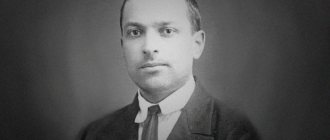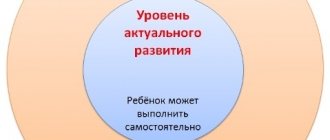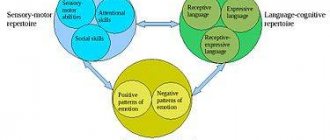Biography of L.S. Vygotsky
L.S. Vygotsky was born on November 17, 1896 in Orsha, the second child in a large family of a bank employee. In 1897, the family moved to Gomel, where it became a kind of cultural center (the father is the founder of the public library).
Lev was a gifted boy and was educated at home. From 1912 he completed his studies at a private gymnasium.
In 1914, after graduating from high school, Vygotsky entered the medical faculty of Moscow State University, and a month later he was transferred to law and graduated in 1917. At the same time, he received an education at the Faculty of History and Philology of the Shanyavsky University.
In 1917, with the beginning of the revolution, the young man returned to Gomel. The Gomel period lasted until 1924 and was the beginning of his psychological and pedagogical activity. Here he marries and has a daughter.
At first he gave private lessons, then taught a course in philology and logic at various schools in the city, and took an active part in the formation of a new type of school. He also taught philology at the Pedagogical College, where he created a consulting room for psychology. Here Vygotsky began his psychological research.
In 1920, Lev contracted tuberculosis from his brother, who died.
In 1924 he was invited to the Moscow Institute of Experimental Psychology. From that moment on, the Moscow period of the scientist’s family began.
In 1924 – 1925 Vygotsky created his own cultural and historical psychological school on the basis of the institute. He began to become interested in working with special needs children. Continuing his psychological research, he simultaneously worked in the People's Commissar of Education, where he proved himself to be a talented organizer.
Through his efforts, an experimental defectology institute was created in 1926 (now the Institute of Correctional Pedagogy). He headed it until the end of his life. Vygotsky continues to write and publish books. From time to time the illness put him out of action. In 1926 there was a very severe outbreak.
From 1927 – 1931 The scientist published works on the problems of cultural-historical psychology. During these same years, he began to be accused of retreating from Marxism. It became dangerous to study psychology, and Vygovsky devoted himself to pedology.
The disease periodically worsened, and in 1934 Lev Semenovich died in Moscow.
Aesthetic art concept
The methodology of Vygotsky’s aesthetic concept is in many ways similar to the already discussed cultural-historical concept. The scientist focused on two closely interrelated components of art. On the one hand, art influences life and the perception of life, on the other, it itself is largely predetermined by life and the perception of life.
In order to understand and understand the essence of a particular work of art, Vygotsky proposed disassembling its structure. The work had to highlight two key elements: form and material. Material, according to Vygotsky’s concept, should be considered what the work consists of: letters and words, if it is a literary work, words and sounds, if it is a theatrical production. In turn, form refers to one or another configuration of the material: poetry, prose, and so on.
Further, in order to make his conclusions more clear, Vygotsky proposed considering a work of art as a kind of anthropomorphic subject with its own anatomy and physiology. Structure is anatomy, and the interaction of structural elements is physiology. In relation to a literary work, this means that you first need to separate the plot and the plot (form and material), and therefore study their interaction.
According to Vygotsky, the secret of a successful literary work lies in the conflict between plot and fable, and the form must prevail over the material. This was a fundamentally new view of art, since before Vygotsky it was believed that plot and plot should cooperate harmoniously. However, Vygotsky saw this problem quite differently. Here it would be appropriate to note that Vygotsky was not only a great scientist, but also an avid theatergoer: he attended all the premieres in Moscow theaters when he studied and worked in Moscow, and in other cities where the fate of a scientist took him.
According to contemporaries, he was personally acquainted with Meyerhold, Stanislavsky, Eisenstein, Aikhenvald, and Mandelstam. He began writing his first theater reviews while still a student, and as his graduation thesis he presented a two-hundred-page work devoted to Shakespeare's play Hamlet. The key work that most fully reveals the essence of the aesthetic concept is considered to be Lev Vygotsky’s “Psychology of Art,” which was presented and defended as a dissertation in 1925.
Main directions of Vygotsky's research
Vygotsky was, first and foremost, a psychologist. He chose the following areas of research:
- comparison of adults and children;
- comparison of modern man and ancient man;
- comparison of normal personality development with pathological behavioral deviations.
The scientist drew up a program that determined his path in psychology: to look for an explanation of internal mental processes outside the body, in its interaction with the environment. The scientist believed that these mental processes can only be understood through development. And the most intensive development of the psyche occurs in children.
This is how Vygotsky came to an in-depth study of child psychology. He studied the patterns of development of normal and abnormal children. In the process of research, the scientist came to study not only the process of child development, but also his upbringing. And since pedagogy is the study of education, Vygotsky began research in this direction.
He believed that any teacher should base his work on psychological science. This is how he connected psychology with pedagogy. And a little later, a separate science in social pedagogy emerged - psychological pedagogy.
While engaged in pedagogy, the scientist became interested in the new science of pedology (knowledge about the child from the point of view of various sciences) and became the main pedologist of the country.
He put forward ideas that revealed the laws of cultural development of the individual, his mental functions (speech, attention, thinking), explained the internal mental processes of the child, his relationship with the environment.
His ideas on defectology laid the foundation for correctional pedagogy, which began to practically help special children.
Vygotsky did not develop methods for raising and developing children, but his concepts of the proper organization of education and upbringing became the basis of many developmental programs and systems. The scientist’s research, ideas, hypotheses and concepts were far ahead of their time.
Developmental education
For the first time in Russian psychology, Vygotsky began to study the relationship between learning and human development. By the term “development” he understood gradual changes in the physiology, behavior and thinking of a child. They occur over time under the influence of the environment and natural processes in the body.
Changes are taking place in several areas:
- Physical - changes in the structure of the brain, internal organs, motor and sensory skills.
- Cognitive - in mental processes, mental abilities, imagination, speech, memory.
- Psychosocial - in personal behavior and emotions.
These areas develop simultaneously and are interconnected. There is a need to draw up an approximate schedule for the appearance of specific forms of behavior in children. Lev Semenovich Vygotsky developed the doctrine of age as a central problem in theoretical psychology. As well as teaching practice.
In subsequent years, Soviet scientists V. Davydov, P. Galperin, M. Enikeev and others, based on the theories of L. S. Vygotsky about the psychology of child development, developed the concept of developmental education. That is, the scientist’s works were continued by his followers.
Principles of raising children according to Vygotsky
The scientist believed that education does not consist in adapting the child to the environment, but in the formation of a personality that goes beyond this environment, as if looking forward. At the same time, the child does not need to be educated from the outside, he must educate himself.
This is possible with proper organization of the education process. Only the personal activity of a child can become the basis of education.
The teacher should only be an observer, correctly guide and regulate the child’s independent activity at the right moments.
Thus, education becomes an active process from three sides:
- the child is active (he performs an independent action);
- the teacher is active (he observes and helps);
- The environment between the child and the teacher is active.
Education is closely related to learning. Both processes are collective activities. The structure of the new labor school, which Vygotsky created with his students, is based on the principles of the collective process of education and training.
Unified Labor School
It was the prototype of a democratic school based on a creative, dynamic, collaborative pedagogy. It was ahead of its time, imperfect, and made mistakes, but it was still successful.
Vygotsky’s ideas were implemented by teachers Blonsky, Wenzel, Shatsky and others.
The pedological theory was tested at the school:
- there were rooms for psychological and pedological diagnostics;
- constant medical and psychological monitoring was carried out;
- classes were created according to the principle of the child’s pedological age.
This school existed until 1936, when the Soviet authorities began attacking it. The school was repurposed as a regular one.
The very idea of pedology was distorted, and it fell into oblivion. Pedology and the idea of a labor school received a second life in the 90s. with the collapse of the USSR. A unified labor school in the modern sense is a democratic school, very appropriate in today's education.
Development and education of special children
Vygotsky developed a new theory of abnormal child development, on which defectology is now based and all practical correctional pedagogy is built. The purpose of this theory: the socialization of special children with a defect, and not the study of the defect itself. It was a revolution in defectology.
He connected special correctional pedagogy with the pedagogy of a normal child. He believed that the personality of a special child is formed in the same way as that of ordinary children. It is enough to socially rehabilitate an abnormal child, and his development will follow the normal course.
His social pedagogy was supposed to help the child remove the negative social layers caused by the defect. The defect itself is not the cause of the child’s abnormal development, it is only a consequence of improper socialization.
The starting point in the rehabilitation of special children should be an unaffected state of the body. “We should work with the child based on what is healthy and positive,” Vygotsky.
By starting rehabilitation, you can also start the compensatory capabilities of the special child’s body. The idea of the zone of proximal development has become very effective in restoring the normal development of special children.
Zone of Proximal Development Theory
The zone of proximal development is the “distance” between the level of a child’s actual and possible development.
- The level of actual development is the development of the child’s psyche at the moment (which tasks can be completed independently).
- The zone of proximal development is the future development of the individual (actions that are performed with the help of an adult).
This is based on the assumption that a child, learning some elementary action, simultaneously masters the general principle of this action. Firstly, this action itself has a wider application than its element. Secondly, having mastered the principle of action, you can apply it to perform another element.
This will be an easier process. There is development in the learning process.
But learning is not the same as development: learning does not always push development; on the contrary, it can become a brake if we rely only on what the child can do and do not take into account the level of his possible development.
Learning will become developmental if we focus on what the child can learn from previous experience.
The size of the zone of proximal development is different for each child.
It depends:
- on the needs of the child;
- from its capabilities;
- on the willingness of parents and teachers to assist in the development of the child.
Article:
The theory of developmental learning originates in the works of I.G.
Pestalozzi, F.A. Disterweg, K.D. Ushinsky and others. The scientific basis for this theory is given in the works of L.S. Vygotsky. Developmental education is a productive implementation of the principle of advanced development of education. The term “developmental education” owes its origin to V.V. Davydov. Introduced to designate a limited range of phenomena, it quickly entered into mass pedagogical practice. Developmental learning as a new, active-activity method (type) of learning, replacing the explanatory-illustrative method (type). Developmental education takes into account and uses developmental patterns and adapts to the level and characteristics of the individual. Developmental learning occurs in the child's zone of proximal development. Developmental education is the orientation of the educational process towards human potential and their implementation.
In the 1960s a scientific team was created under the leadership of psychologists D.B. Elkonin and V.V. Davydov, who studied the significance of primary school age in human mental development. It was revealed that in modern conditions at this age it is possible to solve specific educational problems, subject to the development of educational activity and its subject, abstract theoretical thinking, and voluntary behavior control.
The content and methods of teaching are predominantly focused on developing the foundations of empirical thinking; from the point of view of children's development, they are not effective. Education should form theoretical thinking, which has its own special, different from empirical, content (D.B. Elkonin, V.V. Davydov).
Developmental education is a direction in the theory and practice of education, focusing on the development of the physical, cognitive and moral abilities of students by using their potential. The foundations of the theory of developmental learning were laid by L. S. Vygotsky in the 30s of the twentieth century when he considered the issue of the relationship between learning and development. F. Froebel, A. Disterweg, and K. D. Ushinsky sought to solve problems of development and training from different positions.
In the 30s of the twentieth century, the German psychologist O. Selz conducted an experiment that demonstrated the influence of education on the mental development of children. At that time, three main approaches to solving this issue prevailed. In the interpretation of the supporters of the first approach - A. Gesell, Z. Freud and J. Piaget - human development does not depend on learning. Learning was viewed as a process that in one way or another must be consistent with the course of development, but in itself does not participate in development. According to this theory, development “must go through certain complete cycles and certain functions must mature before the school can begin to teach specific knowledge and skills to the child. Cycles of development always precede cycles of learning.” Thus, “any possibility of raising the question of the role of learning itself in the course of the development and maturation of those functions that are activated by learning is excluded. Their development and maturation are a prerequisite rather than a result of learning. Learning is built on top of development, without changing anything essentially” (Vygotsky L.S. Pedagogical Psychology, 2nd ed. 1991. P. 376).
One of the central problems of psychological and pedagogical science is to reveal the connections between the development of a child’s psyche and his education and upbringing. By the beginning of the 30s. XX century There have been three main theories devoted to this problem.
The first of them can be called the theory of independence of mental development from training and education (A. Gesell, Z. Freud, J. Piaget, etc.). According to the theory of J. Piaget, mental (intellectual) development is interpreted as independent of the upbringing and education of children specially organized by adults. It is presented as a process subject to natural laws and proceeding according to the type of maturation, and learning is understood as a purely external use of opportunities that arise in the process of development. This theory corresponds to the didactic principle of accessibility, according to which children can be taught only what they can understand, for which their cognitive abilities have already matured. This theory does not recognize so-called developmental learning.
The second theory, on the contrary, proves the existence of a relationship between development and learning (G. S. Kostyuk, N. A. Menchinskaya, etc.). According to this theory, development is determined by certain internal factors and, at the same time, by training and education, the specific nature of which depends on the actual level of human development.
The third theory believes that the mental development of a child is mediated by his training and upbringing. This position was most extensively discussed in the works of the scientific school of L. S. Vygotsky.
L.S. Vygotsky introduced the concept of “zone of proximal development” into psychological science, expressing the internal connection between learning and development. The presence of this zone presupposes the formation in the child of mental characteristics that are not yet present in him. At the same time, training and education in themselves are not identical to the processes of mental development. But properly organized training, from the point of view of L. S. Vygotsky, leads to children’s mental development, brings to life a whole series of development processes that would be impossible without training.
A number of provisions of L.S. Vygotsky is concretized and justified by a certain subject content in the works of A. N. Leontyev, P. Ya. Galperina, D.B. Elkonin and others. The followers of the founder of the theory of developmental learning in their research proved the following provisions of the theory of developmental learning:
1. The child is the subject of all types of human activity.
2. Mental processes develop in the course of human activity.
They defined the concepts of the leading type of activity (the basis of children's periodization of human development), developmental education (a system of comprehensive and intensive development of the child, the development of the child's intellectual abilities, a direct focus on the mental and personal development of children).
Child development is a complex, multi-component process, which in one proportion or another includes formation, formation and self-development.
It is advisable to use games with buttons when drawing up developmental programs for the development of the intellectual, emotional, communicative, personal, volitional and cognitive spheres of children. When compiling them, it is necessary to take into account the principles characterizing developmental processes in childhood and adolescence:
Creative nature of development. The main thing in development should not be the assimilation of experience, but its generation.
The leading role of the sociocultural context of development. Curriculums for teaching and raising children should be filled with cultural and historical contexts and parallels.
The leading role of sensitive periods of development. It is important to master certain cultural content in the most favorable period for this and build this process on the basis of the capabilities of the child’s body.
Joint activity and communication as a driving force of development, as a means of training and education.
Leading activity, the laws of its change as the most important basis for the periodization of child development.
The zone of proximal development as a method for diagnosing abilities and possible steps in a child’s development.
Amplification of child development as a necessary condition for the versatile upbringing of a child.
The enduring value of all stages of child development. Each period of a child's life contributes to the developmental process and should be lived fully.
The principle of the unity of affect and intellect, or the principle of an active figure. Training programs should be focused on developing not only the intellect, but also the emotional sphere of the individual.
The mediating role of sign-symbolic structures in the formation of connections between objects and actions. Symbolization should become a principle of child development.
Interiorization and exteriorization as mechanisms of development and learning. Transitions from external to internal and from internal to external are important in development.
Uneven development and formation of mental actions. This principle is especially important to take into account when developing development standards and diagnosing its level (V. P. Zinchenko and E. B. Morgunov).
When starting to develop a program of developmental work with preschool children, a psychologist must focus on knowledge of the basic psychological patterns of child development in different periods of childhood and take into account the individual characteristics of a particular child. In addition, it should be borne in mind that there is widespread mutual compensation between the developmental influence of different types of children's activities. For example, modeling, designing, drawing, coloring, sewing, and mosaics all contribute to the development of fine motor skills. Therefore, preference should be given to those activities that can be better organized by adults and for which the child himself is more inclined. Buttons for children are of undoubted interest.
Games should be selected in accordance with age characteristics and lesson topics. The sequence of presentation of games and their number in the program may vary depending on the interests of the children and the results of the psychologist’s observation. In our opinion, the structure of a group lesson should include the following elements: a greeting ritual, a warm-up, the main content of the lesson, reflection on the current lesson, and a farewell ritual.
Classes are held in premises in compliance with sanitary and hygienic standards and rules.
Games with buttons can be used in group and individual work. Individual work is built taking into account the characteristics of a particular child, and the selection of games varies accordingly.
The composition of the groups and the duration of classes depend on the age category of the children.
| Age | Number of children in the group | Class time |
| 3-4 years | 4-5 children | 20 minutes |
| 4-5 years | 5-6 children | 20 minutes |
| 5-6 years | 6-7 children | 25 minutes |
| 6-7 years | 6-7 children | 30 minutes |
Button games can be used in developmental programs during the school year, varying and modifying them. Developmental work using button games begins approximately from October to April.
Developmental work with preschool children
Creating an objectively and subjectively rich environment for the child and timely introduction of new experiences for him is the essence of the work on the development of preschool-aged children.
Developmental work with a preschool-aged child is not based on the principle of special development of individual mental processes, but is aimed at a general, maximally comprehensive familiarization of the child with the world of objects, people and relationships, during which the gradual development, improvement and complication of all mental cognitive processes and personality occur generally.
The general meaning of an action mastered by a child can only be realized if it is performed as shown by an adult. This is true not only for mastering objective actions, but also for the development of speech: the child learns the name of an object given by adults and the function that it performs in a given specific situation. During this period, the child’s actions are caused directly by objects, and desires have not yet become his personal desires. Adults replace one object that is attractive to the child with another and thus control his desires and actions. improve - the child masters subtle movements of the hands and fingers; begins to hold a pencil, fasten a button, spin a top, etc. In the process of various activities, further sensory development occurs. Objective activity continues to occupy a large place in the child’s activity, but the child’s attitude towards his actions is already somewhat different - the child either persistently strives to obtain a certain result, or these actions are in the nature of experimentation. Logical connections are established between individual actions, and the number of objects used by children increases. However, at the border of early and preschool age, the relationship of joint activity comes into conflict with the new level of child development. Tendencies toward independent activity arise; the child develops his own desires, which may not coincide with the desires of adults. The emergence of personal desires transforms the action into volitional action, on the basis of which the possibility opens up for the subordination of desires and the struggle between them. This also becomes a prerequisite for the development of creative activities in preschool age.
You can organize work with buttons as follows:
Work must be done individually, under the close supervision of an adult. You should select large buttons, focusing on safety precautions. The games last from 5 to 15 minutes. You can use the following games: “Button Train”, “Independent Discovery”, “Button Piggy Bank”, “More - Less”, “Button and Handkerchief”. You can teach your child how to fasten and unfasten buttons, and invite him to lay out some arbitrary design or pattern from them. You can make a list of button games and recommend them to parents as homework.
Developmental work with children of primary and secondary preschool age (3-5 years). Preschool age is the period of emergence and development of plot and role-playing games. At this stage, it becomes possible to conduct more complex collective games that contribute to the development of various mental functions and personal qualities, the acquisition of communication skills and interaction with peers, and the development of arbitrariness. The level of mental and personal development of children 3-5 years old already allows them to conduct specially organized individual and group developmental classes, built in a playful form. Within certain limits, the child is already capable of independent action and experiences an urgent need to realize this new ability. Accordingly, the child becomes available to games that require him to have a certain amount of independence. The participation of an adult in these games comes down mainly to his presence next to the children and to minor assistance provided to them at their request. However, the complete removal of an adult from the game leads to its cessation, and if we are talking about any productive activity, then to a sharp decrease in the quality of its implementation.
Children not only demonstrate the ability to play independently, but also feel the need for it. Play at this age can become a means of correcting a child’s behavior, performing a certain psychotherapeutic function. Experience shows that giving the child the opportunity to organize the game himself, which, in essence, is of an object-manipulative nature, but still has some primitive plot basis, can remove or weaken the acute manifestations of the symptoms of the three-year-old crisis. It is important that neither adults nor other children interfere in this game: the initiative for all plot twists and subject transformations should belong to the child himself.
In accordance with this, educational games for children under three years of age should be limited to a visual and effective plan. Games that require reliance on a visual image are inaccessible to them (for example, a child can assemble a fairly complex cut-out picture by matching one element to another, but he is not able to do this based on a ready-made sample; he also cannot put together a mosaic pattern according to model, but will gladly lay out his own “picture”), games with complex rules that he is unable to remember and adequately apply. Buttons for children are of undoubted interest. It is worth offering them games to develop their imagination, such as “Fold a Pattern”, asking them to make simple crafts from plasticine and decorate them with buttons. With children of this age, it is advisable to use games aimed at correcting and developing the sensorimotor sphere (hand motor skills, general coordination of movements, reinforcing the concepts of “color”, “size”).
Recommended games:
“Train made of buttons”, “ Tracks”, “ Switch places”, “Independent discovery”, “Button piggy bank”, “More is less”, “ Buttons and a handkerchief” , “Button soups”, “Find the same one” , “ Big - small”, “Magic bag”, etc. You can set children the task of comparing, distinguishing, and selecting buttons for a specific purpose (for example, a button of the same color or shape). ( See Attachment.)
You can start using buttons for kinesiological exercises1, thus developing the child’s mental abilities and physical health. The use of a certain set of exercises with buttons can improve a child’s memory, attention, fine and gross motor skills, reduce fatigue, and increase the ability for voluntary control. Under the influence of kinesiological training, positive structural changes occur in the body. Strength, balance, mobility, plasticity of nervous processes are carried out at a higher level. The regulatory and coordinating role of the nervous system is improved. Of course, these exercises should be used selectively, taking into account the child’s capabilities. Example: “Lifting buttons”, “Circles on the palm”. The game “Lifting Buttons” can be played with one child or with a subgroup. In a subgroup, children pass several buttons in a circle, holding them alternately with different fingers. The middle and ring fingers in children of this age are poorly developed, so you should not focus on the inability to use them correctly. By the age of four, most children begin to cope with such games, first very simple, and then more complex. It is worth offering them games to develop their imagination, such as “Fold a Pattern”, asking them to make simple crafts from plasticine and decorate them with buttons.
For children 4-5 years old, it is necessary to complicate games, since games and exercises with special didactic toys and materials lose their leading importance, although they are performed by children at a more complex level. For example, select buttons not only in primary colors, but also use halftones. Buttons are used to lay out simple patterns, various button games that develop the eye and coordination of hand movements. You can offer children button lotto. The task of the psychologist during this period is to notice and support the attempt to introduce children to a new game, and, if necessary, clarify with them the content and rules of such a game; help find a partner, distribute the roles of players.
It is the direct participation of an adult that gives these games and exercises an educational character. With the help of an adult, children identify the desired feature, distinguish and group objects according to their properties, learn to act according to the psychologist’s suggestions, and ultimately achieve the desired result. When various additions are made to games that do not disrupt their progress, children get used to acting in changed conditions.
Recommended games:
“Castanets”, “Nail the Button”, “Funny Snake”, “Continue the Pattern”. In connection with the development of fine motor skills, kinesiological exercises can be complicated. The following exercises are added: “Strong fingers”, “Walking fingers”.
Developmental work with children of senior preschool age.
Senior preschool age immediately precedes the child’s transition to the next, very important stage of his life - entering school. Therefore, preparation for school begins to occupy a significant place in work with children of the sixth and seventh year of life.
Two aspects can be distinguished here: firstly, the ongoing targeted development of the child’s personality and cognitive mental processes that underlie the child’s successful development of the curriculum itself in the future, and secondly, the teaching of primary school skills (elements of writing, reading, counting ).
The problem of a child’s readiness for schooling is considered today primarily as a psychological one: priority is given to the level of development of the motivational-need sphere, the arbitrariness of mental processes, operational skills, and the development of fine motor skills of the hand.
Organization of work with buttons for children 5-6 years old.
In enriching children’s vocabulary, didactic games occupy a significant place, in which children clarify their ideas (for example, about the properties of buttons). Logical exercises can easily be given the form of a game. For example, an exercise to eliminate an “extra” item could be carried out like this: “Here is one button from a material that does not suit all the others. Choose it,” says the psychologist, pointing to the laid out buttons... The game “Day - Night” is played with interest. The teacher says: “Day!” Children look at the laid out buttons. "Night!" - children close their eyes, and the teacher replaces one or more buttons. "Day!" - children determine what has changed, whether it is now possible to name all the objects shown in the picture in one word. More complex ones are added to the games listed above (“Guess what button we have in mind?”).
At this age, you can use games aimed at developing the emotional-volitional sphere: “Family Stories”, “Family Tree”, “Grandma’s Button”. They can also be used to correct parent-child relationships.
Recommended games: “How many buttons are in a box”, “Corners”, “Tower”, “Abacus”, “Numbers”, “Buttons on a wire”. The set of kinesiological exercises becomes more complex: “Dexterous fingers”, “Big - small”.
Six- to seven-year-old children show significant independence in developing the plot of the game; elements of creativity are felt in their play activities. Children of this age are able to subordinate their activities to a set goal and correctly evaluate the results obtained.
The psychologist’s task is to support creative imagination, strengthen children’s ability to perform button patterns that are more complex than in the older group, presenting a larger number of buttons; Emphasize the importance of pre-thinking and planning for creative activities and play. It is important to continue working on organizing joint actions for creative games with buttons (what to agree on, how to prepare to perform actions together, etc.).
As a rule, in the preparatory group, joint complex patterns and pictures of buttons are made in repeated classes, after a similar design has been completed by the children individually.
First, preschoolers are offered simple exercises together. The rules that were learned in the older group are clarified, the motives for choosing a topic and the subsequent game are determined. Very often, children do not adhere to the rules of joint activities, because they do not understand the need to comply with them. Children of this age are able to subordinate their activities to a set goal and correctly evaluate the results obtained.
When working with children, the psychologist’s attention should be directed to improving their skills in organizing play: strive to ask children questions as much as possible, give them the opportunity to think, reason, and patiently listen to the opinions of their peers.
The button game at this age is used in all school readiness classes to master the operations of logical thinking (analysis, classification, synthesis).
Recommended games : “Rugs”, “How many buttons are in a box”, “Corners”, “Tower”, “Abacus”, “Numbers”, “Button Man”, “Button Tree”, etc.
The set of kinesiological exercises we propose can be used in full. Particular attention should be paid to exercises that involve not only the first three fingers, but also the ring and little fingers. These fingers are usually passive in everyday activities. Therefore, the exercises are carried out so that all fingers are involved.
In consultations with parents, it is worth recommending the use of buttons to symbolize routine moments (see the “Daily Routine” exercise in the appendix).
Developmental work is the solution of development problems that are relevant today for a given particular child, a given group of children of a certain age and stage of collective development, for children of a given institution, etc. In the course of solving these problems, the child acquires new psychological abilities, skills and abilities.
The development of certain abilities, qualities, and skills of a child occurs if certain conditions are created by adults. The creation and implementation of such developmental conditions constitute an essential part of the professional competence of an educational psychologist. The button games we offer will help diversify the possibilities of developmental work.
Corrective exercises and didactic games with buttons are carried out both with a group of children and individually; both the whole lesson and part of it.
A wide variety of buttons allows us to use them for correctional and developmental games to familiarize and reinforce concepts such as color, shape, size. By practicing with buttons, the child develops coordination of movements, achieving accurate completion of the task; perseverance and arbitrariness of mental processes, trains the auditory, visual and kinesthetic channels of perception. One cannot underestimate the relaxation effect on the child’s body of various manipulations with buttons, the child’s desire to endlessly touch and finger them.
Button games are easy to use, manipulation with buttons is environmentally friendly and does not cause allergies. Buttons do not get dirty, they cannot be cut or pricked, they are easy to wash and handle.
We examined the theoretical foundations of developmental work, listed the principles characterizing developmental processes in childhood, described the conditions for organizing group and individual developmental work, and created a file of button games, which we successfully use in developmental work with preschoolers.
Bibliography
- Volkov B.S., Volkova N.V. Psychology of human development: Textbook for universities. - Moscow: Academic Project, 2004.
- Vygotsky L. S. Pedagogical psychology. - M., 1996. 580 p.
- Grabenko T.M., Zinkevich-Evstigneeva T.D. Corrective, developmental, adaptive games.— St. Petersburg: “CHILDHOOD-PRESS”
- Intellectual development and education of preschool children: Proc. aid for students higher ped. textbook institutions / L.G. Niskanen, O.A. Shagraeva, E.V. Rodina, etc.; Ed. L.G. Niskanen. - M.: Publishing House, 2002. - 208 p.
- Kurazheva N.Yu., Varaeva N.V., Tuzaeva A.S., Kozlova I.A. "Seven-flowered flower." Program for the intellectual, volitional, emotional development of children 5-6 years old. - St. Petersburg: Speech; M.:Sfera, 2012.- 155 p.
- Kutepova I. Why does a psychologist need buttons? // Hoop-2011- No. 11.
- On the concept of developmental education. Davydov V.V. // Questions of psychology. - 1995. - No. 5.
- Practical educational psychology; Textbook 4th ed. / Edited by I.V. Dubrovina - St. Petersburg: Peter, 2004. - 592 p.
- Pecheroga A.V. Educational games for preschoolers. - M.: VAKO, 2008. - 192 p. — (Preschoolers: we teach, develop, educate).
- Bityanova M.R. Working with a child in an educational environment: solving problems and problems of development.: Scientific and methodological manual for psychologists and teachers. - M.: MGPPU, 2006. - 96 p.
Vygotsky's merits in pedology
At the beginning of the 20th century, educational psychology appeared, which was based on the fact that learning and upbringing depend on the psyche of a particular child.
The new science did not solve many problems of pedagogy. An alternative was pedology - a comprehensive science about the full age development of a child. The center of study in it is the child from the point of view of biology, psychology, sociology, anthropology, pediatrics, and pedagogy. The hottest problem in pedology was the socialization of the child.
It was believed that child development proceeds from the individual mental world to the external world (socialization). Vygotsky was the first to postulate that the social and individual development of a child are not opposed to each other. They are simply two different forms of the same mental function.
He believed that the social environment is the source of personal development. The child absorbs (makes internal) those activities that came to him from the outside (were external). These types of activities are initially enshrined in social forms of culture. The child adopts them by seeing how other people perform these actions.
Those. external social and objective activity passes into the internal structures of the psyche (interiorization), and through general social-symbolic activity (including through speech) of adults and children the basis of the child’s psyche is formed.
Vygotsky formulated the basic law of cultural development:
In the development of a child, any function appears twice - first in the social aspect, and then in the psychological (i.e., first it is external, and then it becomes internal).
Vygotsky believed that this law determines the development of attention, memory, thinking, speech, emotions, and will.
Cultural-historical concept and doctrine of higher psychological processes
The essence of Vygotsky’s cultural-historical concept is that the scientist considers it necessary to fundamentally distinguish between lower and higher psychological functions that directly influence human behavior. Vygotsky emphasized that, we quote, “consciousness determines life, but it itself arises from life.”
The scientist identified two plans of human behavior: the so-called “natural” or “natural”, predetermined by the biological component and not regulated by the will of man, and the so-called “cultural”, “socio-historical”, completely controlled by man. Vygotsky classified all aspects of behavior that a person is able to regulate as higher psychological processes, and those that a person cannot consciously influence, respectively, as lower psychological functions.
According to the situation in the 20-30s of the last century, this approach was a real breakthrough, since most scientists either idealized psychological functions as such, considering them to be fully conscious, or reduced them to a chain of biological and physiological reactions. Moreover, Vygotsky was, perhaps, the first who undertook to describe and systematize different aspects of similar psychological reactions.
Thus, within the framework of the cultural-historical concept, it is worth highlighting Vygotsky’s theory of attention. According to his theory, attention can be both involuntary, that is, a lower mental function, and conscious, that is, related to higher psychological functions. Involuntary attention prevails in the very first years of a child’s life. Accordingly, voluntary, that is, conscious attention, is already a characteristic of a more mature personality.
Thus, Vygotsky derives the following characteristics of psychological functions, according to which they can be classified as higher: sociality, arbitrariness, indirectness, systematicity. Such a classification, even if it is not flawless and the only correct one, nevertheless significantly simplifies the analysis and systematization of many observed phenomena.
The influence of communication on raising a child
A child develops quickly and masters the world around him if he communicates with an adult. At the same time, the adult himself should be interested in communication. It is very important to encourage your child's verbal communication.
Speech is a sign system that arose in the process of socio-historical development of man. It is able to transform children's thinking, helps solve problems and form concepts. At an early age, a child’s speech uses words with a purely emotional meaning.
As children grow and develop, words of specific meaning appear in their speech. In older adolescence, the child begins to designate abstract concepts in words. Thus, speech (word) changes the mental functions of children.
The mental development of a child is initially controlled by communication with an adult (through speech). Then this process moves into the internal structures of the psyche, and inner speech appears.
Laws of age development
L. S. Vygodsky formulated several general provisions in the psychology of child development:
- Age-related development has a complex organization, its own rhythm, which changes at different periods of life;
- Development is a sequence of qualitative changes;
- The psyche develops unevenly, each side has its own period of change;
- Higher mental functions are collective forms of behavior and only then become individual functions of a person.
Criticism of Vygotsky's ideas
Vygotsky's research and ideas on psychological pedagogy were subjected to the most vehement condemnation.
His concept of learning, based on the zone of proximal development, carries the danger of pushing forward a child who does not have sufficient potential. This can dramatically slow down children's development.
This is partly confirmed by the current fashionable trend: parents strive to develop their children as much as possible, without taking into account their abilities and potential. This dramatically affects the health and psyche of children and reduces motivation for further education.
Another controversial concept: systematically helping a child perform actions that he has not mastered on his own can deprive the child of independent thinking.
Dissemination and popularity of Vygotsky's ideas
After the death of Lev Semenovich, his works were forgotten and did not spread. However, since 1960, pedagogy and psychology have rediscovered Vygotsky, revealing many positive aspects in him.
His idea of the zone of proximal development helped assess learning potential and proved fruitful. Her outlook is optimistic. The concept of defectology has become very useful for correcting the development and education of special children.
Many schools have adopted Vygotsky’s definitions of age standards. With the advent of new sciences (valeology, correctional pedagogy, a new reading of previously perverted pedology), the scientist’s ideas became very relevant and fit into the concept of modern education, a new democratic school.
Many of Vygotsky’s ideas are being popularized here and abroad today.
Michael Cole and Jerome Bruner incorporated them into their theories of development.
Rome Harré and John Shotter considered Vygotsky the founder of social psychology and continued his research.
In the 90s Valsiner and Barbara Rogoff deepened developmental psychology based on Vygotsky's ideas.
Vygotsky's students were prominent Russian psychologists, including Elkonin, who also worked on problems of child development. Together with teachers, based on Vygotsky’s ideas, he created an effective Elkonin-Davydov-Repkin development program.
It is used to teach mathematics and language according to a special system; it is approved by the state and is now widely used in schools.
In addition, there are still many talented hypotheses and unrealized ideas of Vygotsky that are waiting in the wings.











